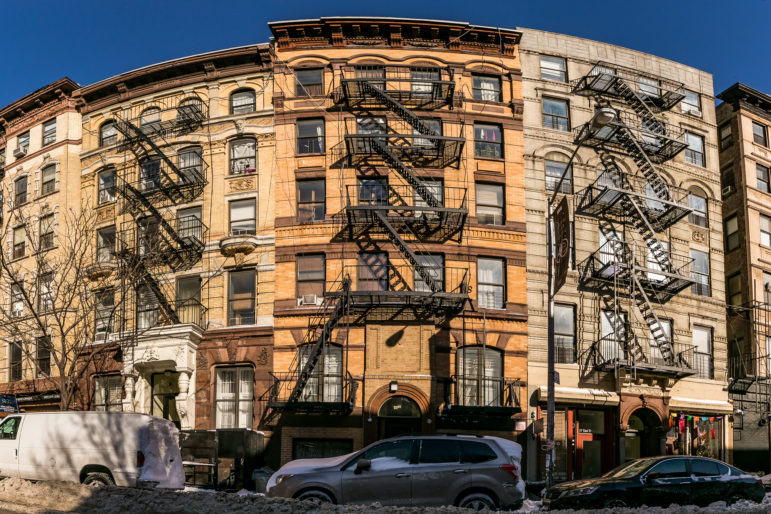
Proposed State ‘Social Housing’ Authority Would Build Affordable Homes Outside the Private Market
The latest housing proposal to hit the state legislature would create a new Social Housing Development Authority (SHDA) to oversee the development of social housing—homes created “for the public good,” instead of profit.
Adi Talwar
Buildings on East 3rd Street in the East Village that are part of a community land trust.
Albany saw the unveiling of a proposal on Tuesday by State Sen. Cordell Cleare and Assemblymember Emily Gallagher to help create thousands of affordable, union-built homes across the state—through a publicly-funded entity focused on social housing models.
The lawmakers’ proposed Social Housing Development Authority (SHDA) would aim to create 26,000 affordable homes using union labor, funded in part by an initial $5 billion dollar injection from New York’s budget and the issuance of bonds.
The state-run public authority would act as an alternative to private sector development, which the bill’s sponsors say has failed to create enough affordable homes to keep up with the state’s growth, citing the current housing shortage, rising rents and surging homelessness.
The SHDA would focus specifically on the creation of social housing—a wide-ranging term used to describe development that prioritizes permanent affordability, democratic resident control, and social equality. It is often owned by public entities, residents, or mission-driven nonprofits, and can accommodate both renters and homeowners.
“Housing is infrastructure,” said Assembly sponsor Gallagher, who expressed the need for the state to take a more direct role in residential development.
“With other forms of infrastructure, whether it’s a new bridge, a subway station, a public school, the government doesn’t just hand over a tax break to a private developer and hope for the best,” she added. “Instead, we use the extraordinary powers of the state to finance, plan and get it built.”
Outlined in the lawmakers’ proposal, the SHDA would have the ability to purchase and improve existing housing in the state to convert into social housing, as well as construct and maintain a variety of mixed income homes. These could include publicly owned rental apartments, Community Land Trusts (CLTs) and cooperatives that prioritize affordability and community control.
Residents in SHDA buildings would pay no more than 25 percent of their gross income toward their housing costs. Additionally, the authority would require that at least a quarter of the housing it creates is for households earning 30 percent or less of the local Area Median Income (AMI)—roughly $38,130 for a family of three. And no more than 30 percent of the SHDA’s units could be occupied by residents earning 100 percent or more of their local AMI, or $127,100 for a three-person household in New York City.
“My constituents want permanently affordable housing that stays 100 percent affordable across generations and allows for people to live, grow and stay in their communities for a lifetime,” State Sen. Cleare, who represents Harlem and is the bill’s main sponsor in the Senate, said in a statement Tuesday.
The legislation comes as political players continue to debate solutions to the state’s ongoing housing crisis. The shortage is particularly acute when it comes to homes for the lowest-income New Yorkers: according to the National Low Income Housing Coalition, the state has a deficit of 655,940 units for “extremely low income” earners—those making at or below 30 percent of the AMI—who make up more than a quarter of its renter households.
Cleare, Gallagher and the bill’s supporters are pitching the SHDA as an alternative to the state’s controversial 421-a program, which gave a tax break for developers so long as they include a percentage of affordable units in their buildings.
The program lapsed in 2022, but Gov. Kathy Hochul has proposed reviving some version of it this year—tentatively dubbed “485-x”—in an effort to boost housing development.
But according to Samuel Stein, a housing policy analyst at Community Service Society (a City Limits funder), the two initiatives could potentially work in tandem.
“One could do both. This could be the public development model and 485-x could be the private development model, but it is the tenant movement saying this [SHDA] is a better way to answer the supply question,” he said explaining that while both plans would have tax exemptions and rules requiring union labor to create mixed income housing, SHDA’s definition of “mixed income” has a much broader definition when compared to 421-a, and would offer more realistic affordability.
The SHDA proposal, Stein argues, “is wildly better from a tenant’s” perspective than 421-a since it would foster permanently affordable homes, while affordability under the latter expires when the program or the building level exemption does.
While part of the authority’s funding would come from state taxpayers, supporters say 421-a is costly, too: a 2022 City Comptroller report found the abatement cost the city nearly $2 billion dollars in missed tax revenue that year, calling the program largely “expensive and inefficient.”
William Alatriste/NYC Council Media Unit
NYC Councilmember Pierina Sanchez, housing committee chair, at a February 2023 rally in favor of a package of city-level social housing bills.
On the local level, progressive city lawmakers have introduced a package of their own social housing bills, including one that would give nonprofits and land trusts the first shot at developing city-owned land, though some have faced a lackluster reception from Mayor Eric Adams’ administration.
The mayor was in Albany Tuesday to make his annual pitch to state lawmakers about the city’s needs. During testimony to the New York State Senate Finance and Assembly Ways and Means Committees, he hammered out some of his housing priorities, including reviving 421-a and making it easier for the city to convert office spaces to homes.
“I think it’s time for us to come together and deal with the inventory crisis that we’re facing and if we don’t we’re going to continue to see an increase in our shelter population,” Adams said.
While the mayor said he also supports “a version of tenant protection,” he did not endorse “good cause” legislation—a bill that’s been prioritized by housing advocates, but opposed by landlord groups, which would give tenants in unregulated apartments the right to challenge evictions without an established “good cause,” like nonpayment of rent.
“I didn’t say I support good cause. I said I support tenant protections,” the mayor told reporters after his testimony, adding that he would like to see state lawmakers “come to a solution” this year on housing. “I think we can land this plane of dealing with our inventory problem and dealing with the concerns of those who are advocating for tenant protections.”
With additional reporting by Emma Whitford.
To reach the reporter behind this story, contact Chris@citylimits.org. To reach the editor, contact Jeanmarie@citylimits.org
The post Proposed State ‘Social Housing’ Authority Would Build Affordable Homes Outside the Private Market appeared first on City Limits.


